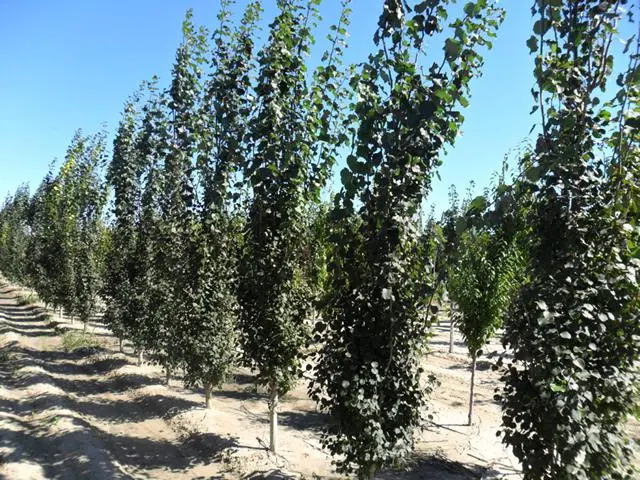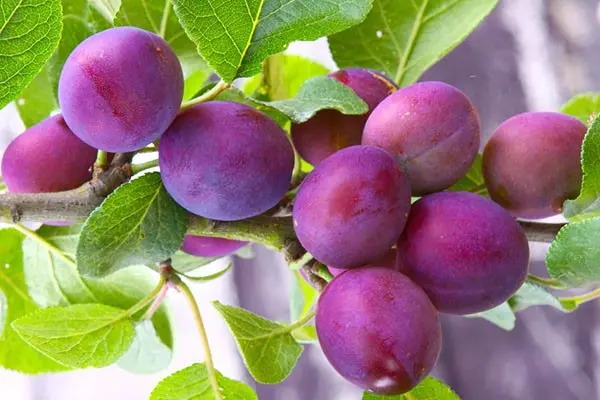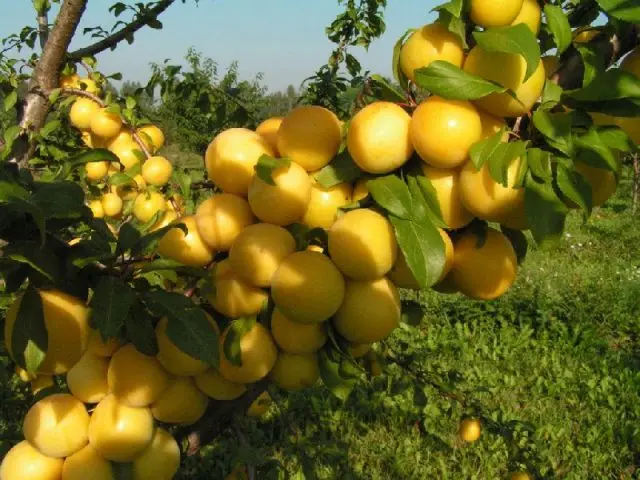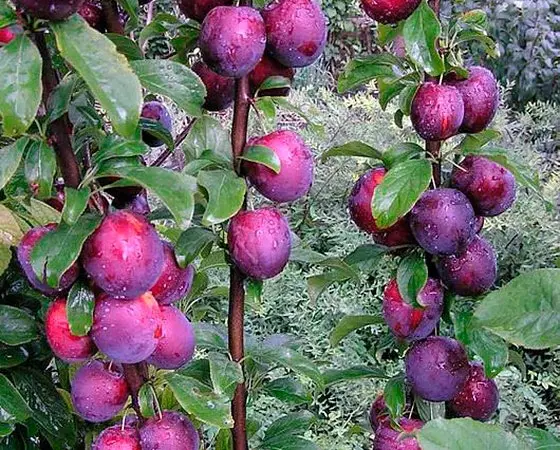Contents
- General description of the columnar plum
- The best varieties of columnar plums
- Plum columnar yellow
- Self-fertile columnar plum
- Varieties of columnar plum for the Moscow region
- Varieties of columnar plum for the Leningrad region
- Varieties of columnar plum for the Urals
- Varieties of columnar plum for Siberia
- Planting and caring for the columnar plum
- Diseases of the columnar plum
- Conclusion
- Reviews
Columnar plum is a fruit plant that is in special demand among gardeners. It is interesting to understand exactly what features characterize the plum.
General description of the columnar plum
This name is given to plums that have a narrow but dense crown, directed vertically upwards. In shape, the trees resemble columns, which is what they owe their name to. Almost all branches of this type of plant are directly involved in fruiting and are represented by thin flexible shoots; it is almost not necessary to form a columnar plum.
Are there columnar plums
Many gardeners doubt the existence of such trees. The fact is that the first plant with an unusual narrow pyramidal crown was the Mackintosh apple tree – and such a crown was the result of a random mutation discovered in the 1960s.
Since then, however, breeding has advanced a lot. Narrow-pyramidal apple trees, pears, plums and other crops were bred artificially.

All these trees are united by the fact that the vertical growth of their branches is a selection feature, and not just another mutation and not the result of crown formation. Therefore, the answer will be positive – columnar plums exist.
What does a columnar plum look like?
The plant is easy to recognize. Its branches are thinner than those of ordinary plums, and are covered with smooth bark. Shoots do not grow to the sides, but upwards at an acute angle, as if trying to cling to the main trunk of the tree.
Characteristics of the columnar plum
Plants of this type differ from ordinary varieties not only in appearance. The description of the columnar plum reveals a number of other features.

- The frost resistance of such trees is very high – even temperatures below – 30 degrees do not harm the health of plum plants.
- The root system of trees is less developed than that of ordinary trees. Therefore, they can be planted almost close – they will not harm either the crowns or the roots of each other.
- Plants are notable for their small height – they rarely grow above 3 m. At the same time, the yield is very high – up to 12 kg per tree.
- Narrow-pyramidal varieties – early ripening. Fruits appear already 2 years after rooting. Up to 7 years, the yield increases year by year – and then it declines. Fruiting usually stops at 13-17 years of age.
The advantages include precocity, high yield, strength and frost resistance. You need to prune the columnar plum in the spring quite a bit, since it has few “extra” branches.

Do you need a pollinator for the columnar plum?
Some varieties have the ability to self-pollinate – for example, Imperial. Others require pollinators for high yields.
The best varieties of columnar plums
Among the varieties, there are several that are respected by gardeners.
Muravushka
It bears its first fruits a year after planting, the crop is harvested in August. Drupes have a dark purple color and a sweet taste; about 4-5 kg of fruits can be collected from one tree. The columnar plum Ant is pollinated by Blue Free, Stanley and other plum trees, and is considered one of the best plum varieties for the Moscow region.
Ruby
The height reaches 2 m, the fruits are red in color, the taste is sweet with a slight sour note. You can harvest in early September. Ruby is a large-fruited variety, the weight of one drupe can be 60 g. Pollinators are not required for the plant. The disadvantages of the columnar plum Ruby include late fruit ripening.

A plant with dark red sweet fruits. The drupes ripen in the second decade of August, and one fruit can weigh up to 40 g. It is successfully pollinated by Ussuri or cherry plum.
Honey
Brings golden-yellow, very sweet fruits weighing up to 50 g. Columnar plum Honey White ripens from the end of July. Pollinated by Hungarian Donetsk and Renklod Karbysheva.
Commander
A variety with medium ripening, with reddish-purple fruits. Plum columnar Commander bears fruit weighing up to 55 g. Self-fertile.
Imperial
The most popular variety among gardeners up to 2 m tall with large fruits up to 55 g. Drupes have a rich dark red color. Ripens towards the end of August. Refers to self-pollinated columnar plum varieties for the Moscow region and other regions.

Blue Suite
Prunes with dark purple fruits weighing up to 75 g. Ripens in August, produces up to 13 kg of sweet-sour drupes per tree. Pollinated by Blue Free and Stanley varieties.
Olenka
A tree with bright red small fruits. The weight of one drupe is only about 25 g. Self-infertile, with a Stanley or Blue Free nearby, it will bring abundant harvests.
Mirabella
A variety with yellow sweet drupes up to 40 g each, resembling apricots in appearance. It bears fruit from mid-August, one tree can produce up to 15 kg of fruit. It can pollinate on its own.
Angie
Mid-season variety with burgundy-purple fruits up to 40 g each, has a pleasant sweet-sour taste. Advantages – self-fertility, good tolerance to low temperatures.
Yellow
Description of the Yellow columnar plum looks like this – it is a variety up to 2 m tall with the earliest fruiting. Drupes ripen by the end of June. The plant produces round and large golden fruits with a honey taste, pollinated independently.

oscar plus
Tree with rounded red or dark brown fruits, 45 – 55 g each. Ripening dates fall at the beginning of September. The variety requires pollination from trees with similar flowering periods.
Plum columnar yellow
Thanks to what qualities are reviews of the columnar yellow plum so positive?
- Early ripening – you can harvest from the end of June or the beginning of July.
- Sweet honey taste of fruits with fruity notes.
- Weighty dimensions of drupes – an average of 40 to 70 g in one fruit.
Varieties of yellow columnar plum are represented by plants Mirabella, Medovaya, Pamyat Timiryazev.
Self-fertile columnar plum
The main reason why gardeners prefer the self-pollinating columnar plum is that there is no need to plant extra trees. This is especially true for small gardens, where it is difficult to place even several small trees at once.

The category includes many varieties, for example:
- Imperial;
- Angers;
- Rubin.
Varieties of columnar plum for the Moscow region
The region near Moscow is considered mild enough for plum trees, in terms of climate. In the Moscow region, plants receive enough light and natural precipitation, but sometimes cold winters and sharp frosts occur in the region in the spring.
Varieties of columnar plum for the Moscow region are mainly represented by Imperial, Medovaya, Blue Sweet, Mirabella and others.
Varieties of columnar plum for the Leningrad region
The main climatic characteristics of the Northwest region are high humidity and cold, which can last until May. It is not worth planting southern varieties or varieties zoned for regions with low humidity.
Imperial and are best suited for the Leningrad region.
Varieties of columnar plum for the Urals
The peculiarity of the Ural region is that the climate here is sharply continental, winters are very cold, frosts can hit even in May.

Cherry plum, or the plum variety, is ideal for breeding in this region. Blue Sweet and Angers varieties can also take root in the region.
Varieties of columnar plum for Siberia
Siberia is the most severe region for growing crops. Winters are long and cold, and summers are hot but very short. Spring frosts occur late, autumn frosts come early. The description of the Rubin plum corresponds to the conditions of the region, the Honey and cherry plum varieties are also suitable.
Planting and caring for the columnar plum
Properly planting a columnar plum in the spring will help the basic rules that are the same for most types of plants.
Site selection and preparation of soil
The soil for the plant is light, not swampy, sandy loam is best. The tree feels good in southern sunny areas.
Caring for the columnar plum begins in advance – fertilizer must be applied to the pit for the seedling. You can do this just before planting, but it’s best a few months before planting the columnar plum in the spring.

Selection of columnar plum seedlings
The main requirement for a young tree is one – it must have healthy, well-developed, strong roots.
How to plant a columnar plum
Planting a columnar plum in the spring is carried out because in the fall the plant may not take root before the onset of cold weather. For a seedling, they dig a fairly spacious hole, lower the tree onto the soil mixed with fertilizers, and cover the roots with earth.
After that, the plant must be immediately watered and the circle near the trunk should be mulched. For even growth, it is recommended to additionally tie the plant to a support.
Top dressing of the columnar plum
The first 2 – 3 years the tree has enough fertilizers applied initially. Then top dressing is introduced three times a year: with nitrogen substances in spring, potassium – in summer, phosphorus-containing – in autumn.
How to prune a columnar plum
You can watch the pruning of the columnar plum in the spring in the video for beginners. Briefly, the basic rules look like this:
- The formation of a columnar plum is usually carried out in the spring before the buds swell.
- When pruning, the top is not touched, but the side shoots are thinned out.
- In the first year of life, pruning a columnar plum includes removing the flowers so that nutrients go to strengthen the root system.
- In spring or autumn, you need to cut the plum for sanitary purposes.
Watering, mulching and winterizing columnar plum
You need to water the tree once a month, with severe drought – more often, as the soil dries. To retain moisture, the near-stem circle can be sprinkled with mulch. However, it is impossible to overmoisten the roots of the tree – the plant does not tolerate waterlogging.
Preparing the plant for winter consists of the final autumn watering, the application of phosphate and organic fertilizers under the trunk. It is recommended to cover the trunk and the ground around with spruce branches – this will not allow the roots to freeze.

Diseases of the columnar plum
The plant is quite resistant to ailments, but you should still remember about the diseases of the columnar plum and their treatment. The tree strikes
- gommosis;
- coccomycosis;
- clusterosporiosis.
Ailments can be avoided if you take good care of the columnar plum. If symptoms of diseases occur, it is necessary to eliminate the affected parts of the plant and treat the tree with copper sulphate, Bordeaux liquid or antifungal drugs.
Conclusion
Columnar plum is ideal for small gardens in any region of the country. High frost resistance, early maturity and abundant fruiting provide her with love from gardeners.











